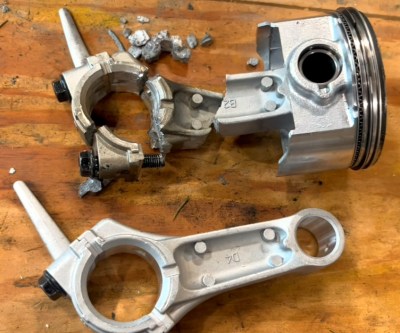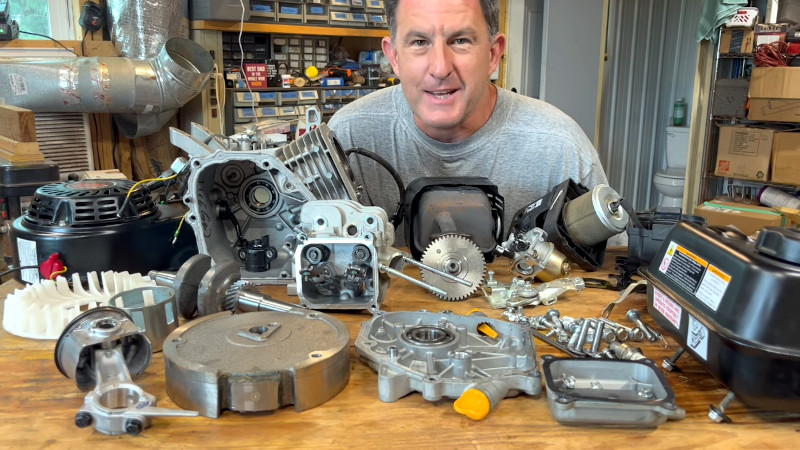When the 6.5 HP (212 cc) Harbor Freight Predator engine in his kid’s go-kart gave up the ghost after some particularly hard driving, [HowToLou] figured it would be a good time to poke around inside the low-cost powerplant for our viewing pleasure. As a bonus, he even got it up and running again.

For an engine that has a retail price of just $160 USD, we’ve got to admit, the inside of the Predator doesn’t look too shabby. Admittedly, [HowToLou] determined that the cause of the failure was a blown connecting rod, but he also mentions that somebody had previously removed the engine’s governor, allowing it to rev up far beyond the nominal maximum of 3,600 RPM. No word on who snuck in there and yanked the governor out, but we’re betting it wasn’t the 7-year old driver…
Replacing the connecting rod meant taking most of the engine apart, but for our education, [HowToLou] decided to take it a bit further and remove everything from the engine. After stripping it down to the block, he re-installs each piece while explaining its function. If you’ve ever wanted to see what makes one of these little engines tick, or perhaps you’ve got a Predator 212 cc in need of a repair or rebuild, the presentation is a fantastic resource.
Incidentally, this isn’t the first time we’ve seen the go-kart in question — back in June, we covered the unique electric reverse that [HowToLou] came up with for it.
















Perfect! As someone who sells these engines on a daily basis a detailed teardown is great information. I really appreciate this.
Time to install a billet aluminum connecting rod.
Will only reveal the next weakest part. Repeat until all parts are replaced. Cheaper just to buy a ‘busa motor to start.
Surprised the case wasn’t ventilated by the stub flopping around.
When you buy a hoopdie motor from Harbor Freight for next to nothing and start souping it up—having a souped up engine isn’t really the point. The point is that this guy has fun doing this, and probably a slight masochistic streak. I’ll bet he can’t wait to reveal the next weakest part and tear it down again. Or maybe I’m just projecting a bit :)
Sticking to my recommendation. Junkyard Hayabusa engine for most fun. His kids would thank me, if they survived.
Good luck finding a Hayabusa engine for $160…
Will the alternative was replacing one part at a time to make a $160 motor stronger.
Time is money. You’d be 10 grand into that $160 motor and still not have decent power.
Can’t polish a turd, best option when asked to polish a turd is to smile, say ‘yes sir’ then cover it in gold spray paint and glitter (quit that job before the shit hits the fan).
People get pretty good power out of these engines. One YouTuber got 22hp (stock is 6.5) out of one. The Robot Cantina and Cars and Cameras YouTube channels have covered these engines, as have other channels whose names I don’t remember. Robot Cantina got a Hona Insight up over 50mph with a modified 212cc Harbor Freight engine.
So, he was able to get a replacement connecting rod, but not a governor, which caused the failure…
Some people just dont learn, Not to mention assembling it without lube.
Not “caused” so much, as “allowed”.
Doesn’t need to find a replacement for the governor, the original one is probably still sitting in his parts bin…
Just got to make sure junior eases up on the gas this time around.
Having worked on various Honda GX160 powered equipment and a few Honda GX200 powered go-carts (as the Predator and Lifan & Lutian engines are clones of Honda’s design) I can safely say that for carts, the governor is more of a hassle than a “engine preserver”.
The real problem here is the “cost optimized” components not suited for “send it” applications where tossing on something like the bigger engines also brings unwanted weight and takes up more space.
So the better solution is to beef the engine up.
Though pre-assembled & factory beefed-up engines based on the Honda GX200 are sold by Tillotson, and some Karting suppliers also sell beefed up Predators or Lifan or Lutian engines, sometimes even with minor changes to suit your application better.
Similar experience here – used to look after a fleet of GX160 powered karts, all with governors removed, and they were insanely reliable, taking a hell of a beating at the hands of customers over thousands of miles.
The governors are/were mostly there for the applications where the engine speed needed to be constant, which is most of the non-kart uses for these.
Amazing how much it looks like a Honda engine inside…oh wait…
These motors were a cheep way to start karting called clone racing , a copy of Hondas. You could buy from HF , buy with the warranty , blow it up, put governor back in and go get a new motor (the blue one).
Then when they found that we used them for racing, HF changed the cc and went to black motors.
There are other clones out there for less than $300 add a billet flywheel, because the iron one would crack and go boom.
Now the race motor is a Lo206 by Briggs and is sealed on bottom end and is hand built to within .oo3 for no modifications. The head can be removed to lap valves. The carb has different slides for Jr classes along with different rev limited ignitions. Still a great starting place for racing with an older used kart and lo206 far less than the big boys toys.
FYI :shifter racers start around $5000 and up to be competitive, spend more $!!!
Still love karting for the freinds and fun.
Removing the governor on these Honda clone engines is quite common and normally very reliable if you stick with the stock valve springs. At high RPM the stock valve springs will allow the valves to float which effectively limits the RPM of the engine to safe levels. If stiffer valve springs are used then the standard recommendation is to change out the cast flywheel and the stock connecting rod. The stock flywheel can come apart catastrophically at higher RPM which is quite dangerous.
You need to understand that the stock governor isn’t installed to prevent the engine from over revving, it’s used to keep the engine at the optimal RPM for typical use in a wood chipper, log splitter, etc. It limits the engine to around 3600-3800 RPM which is where the horsepower and torque ratings are taken (6.5 HP on the HF Predator). But you can definitely spend the engine faster for a go-kart type application. Harbor Freight recently introduced a Predator engine for this exact purpose called the Ghost. It has no mechanical governor and is based off the standard Predator engine. It has larger valves and heavier valve springs so it uses a digital ignition that limits the engine speed to around 5600 RPM.
You can also see substantial power games from spinning the Predator engine past its mechanical governor limited speed. The new Harbor Freight engine puts out around 11HP from the same 6.5HP Predator engine block.
Not the exploding flywheel myth again! The only danger from the stock flywheel is the magnets tend to come flying off over 7k unless you epoxy them down.
The rod obviously failed from overheating or lubrication starvation, possibly both. You can tell from the color that the metal was too hot. Upgrading the oiling system would help reduce the problem. I would suggest rebuilding and blueprint ING any of these cheap Asian sourced engines before you use them, even new out of the box.
I got 6 of the ghost engines and none of them were ready to race! The crank and rod clearance had to be set on all of them. The cylinders are scored from the factory and also needed attention BEFORE we even started them up. They all would have hatched the rod if we had used them out of the box. Two would not even turn over out of the box. Harbor Freight told me to basically get lost before promising to send replacement parts. The parts that were promised never came. BAD BUSINESS.